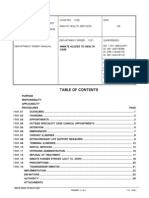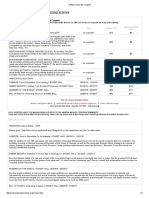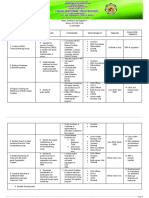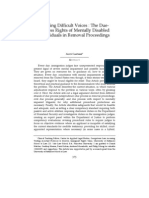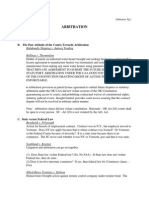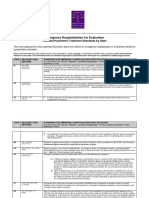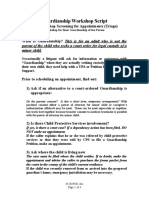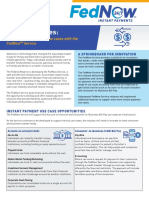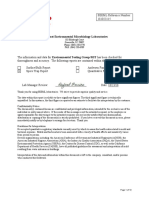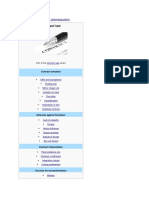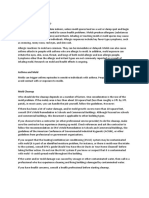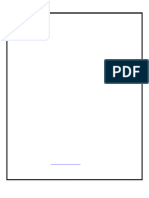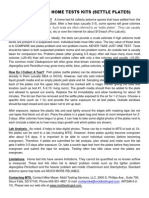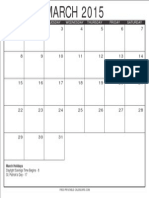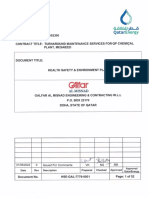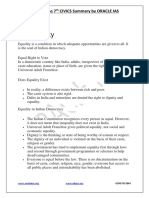1 - Mold Exposure Guide
1 - Mold Exposure Guide
Uploaded by
Jazzy KateCopyright:
Available Formats
1 - Mold Exposure Guide
1 - Mold Exposure Guide
Uploaded by
Jazzy KateOriginal Title
Copyright
Available Formats
Share this document
Did you find this document useful?
Is this content inappropriate?
Copyright:
Available Formats
1 - Mold Exposure Guide
1 - Mold Exposure Guide
Uploaded by
Jazzy KateCopyright:
Available Formats
MTS#8 MOLD EXPOSURE GUIDELINES
General. There are no well accepted numerical guidelines for mold exposure. Some persons are much
sensitive (allergic) to mold than others. There is disagreement as to what levels of exposure and what types of
mold may cause various symptoms. There is general agreement that damp (and often moldy) buildings are
associated with increased health problems.
Visible Mold. Many experts argue that the presence of visible mold in buildings is unacceptable on health and
hygienic grounds (Samson, et.al., 1994, Health Implications of Fungi in Indoor Environments, Elsevier, p.532).
The presence of visible mold indicates dampness has occurred at some time. However, from a practical
perspective, small amounts of visible mold (<1-10 ft2) can often be found in many buildings and may not
always pose a serious health concern. On the other hand, where visible mold is present, much more mold may
be hidden behind walls. Large amounts of visible mold (covering large areas of walls, etc.) are a definite health
concern (regardless of the type of mold). Large amounts of visible mold are often associated with elevated
airborne mold levels. The NY City Health Dept and the US EPA consider visible mold <10 ft 2 to be limited to
where professional cleaning assistance may not be needed.
Types of Mold. Although there are thousands of types (genus-species) of molds, a relatively small number
account for most indoor and water damage situations. Some molds are considered worse (more allergenic or
toxic) than others. The common mold Cladosporium is widespread inside and outside and is typically not
considered as bad as some other molds. The wet black molds Chaetomium and Stachybotrys often occur on
sheetrock and are considered problem molds. They have large spores and tend not to occur at high levels in
the air unless disturbed. They require very damp conditions to grow. The most common problem molds are
Aspergillus-Penicillium. They require only moderately damp conditions for growth. They have very small spores
that are easily airborne and can float in the air for many hours when disturbed.
Visible Mold Tests. Tape or bulk tests can be taken of visible mold. These are useful to verify the presence
and type of mold present. However, it must be emphasized visible mold tests are insufficient to provide an
adequate exposure assessment. This requires site assessment and airborne mold tests. See MTS handout #1
on collecting visible mold tests.
Airborne Mold. The primary health concern from mold is AIRBORNE exposure. There are no well accepted
numerical guidelines. As a rule of thumb, indoor levels should be less than outside (in warm weather) and
elevated levels of the problem indoor molds Aspergillus-Penicillium and Chaetomium-Stachybotrys should not
be present. Based on work at hundreds of buildings, MTS has developed an informal working guide. This is
NOT a formal standard. Activities that disturb mold (clean-up, remodeling,etc) and cause indoor airborne levels
>5000-10,000 total spores/m3 are often associated with health symptoms (especially with high levels of
Aspergillus-Penicillium and/or Chaetomium-Stachybotrys.
Normal (Upper Range) Airborne Indoor Mold Levels (spores/cubic meter)
Type of Mold
Upper Range Most Bldgs
Upper RangeGood Filtration
Total Mold
<2000-4000
<1000-3000
Common Mold
Problem Damp Molds
Problem Wet Molds
Cladosporium
<2000-3000
<1000-2000
Asper.-Penicillium
<1000-2000
<500-1000
Chat.-Stachybotrys
<250-500
<50-250
See Meyer,M, 2009, Paper #203, Healthy Buildings Conference Proc., Syracuse, NY.
Summary provided by Mold Testing Services, LLC. , 2900 S. Phillips Ave., Suite 700, Sioux Falls, SD 57105.
Ph 605-951-4857. E-mail: moldymike@moldtestingsd.com (MTS 5-12-10). See our web site at
www.moldtestingsd.com
You might also like
- FREE PRINTABLE CNA Practice ExamDocument12 pagesFREE PRINTABLE CNA Practice Examheartandhandstraining_com92% (63)
- Ati Medication Template KetorolacDocument1 pageAti Medication Template KetorolacSharee Haywood100% (1)
- New Issues in Mold LitigationDocument14 pagesNew Issues in Mold LitigationJimmy W. FehrmanNo ratings yet
- AZ DOC DO 1101 HealthDocument31 pagesAZ DOC DO 1101 HealthPeggy PlewsNo ratings yet
- HMNS Corporate CouponsDocument2 pagesHMNS Corporate Couponsroh009No ratings yet
- Wins Action Plan 2019Document8 pagesWins Action Plan 2019Girlie Harical Gangawan100% (1)
- Guide For Interpreting Reports From Inspections/ Investigations of Indoor MoldDocument13 pagesGuide For Interpreting Reports From Inspections/ Investigations of Indoor MoldClifford Allen Cooper100% (1)
- EMC Report.Document8 pagesEMC Report.Craig MongerNo ratings yet
- Renter'S Guide To Mold: Your Logo HereDocument2 pagesRenter'S Guide To Mold: Your Logo Herejclark13010100% (1)
- Complaint Form InformationDocument5 pagesComplaint Form InformationSalvadahNo ratings yet
- Business Law Unit - IVDocument9 pagesBusiness Law Unit - IVKaran Veer SinghNo ratings yet
- A Harris Seeds Presentation: Mark Greene Dick Chamberlin Mark WillisDocument41 pagesA Harris Seeds Presentation: Mark Greene Dick Chamberlin Mark WillisbwillisteinNo ratings yet
- Additional Remedies: Concentrate Questions and Answers Contract Law: Law Q&A Revision and Study Guide (2nd Edn)Document15 pagesAdditional Remedies: Concentrate Questions and Answers Contract Law: Law Q&A Revision and Study Guide (2nd Edn)Mahdi Bin MamunNo ratings yet
- Due Process Rights of The Mentally Disabled in Removal ProceedingsDocument42 pagesDue Process Rights of The Mentally Disabled in Removal Proceedingsmarioma12No ratings yet
- Opp To Motion General Packet 2017Document12 pagesOpp To Motion General Packet 2017King FishNo ratings yet
- Arbitration: A. Introduction B. The Past Attitude of The Courts Towards ArbitrationDocument10 pagesArbitration: A. Introduction B. The Past Attitude of The Courts Towards Arbitrationsuperxl2009No ratings yet
- Los Angeles Municipal Code Rent Stabilization ActDocument89 pagesLos Angeles Municipal Code Rent Stabilization ActRandell TaylorNo ratings yet
- Use Case Series Bill PayDocument2 pagesUse Case Series Bill PayLaLa BanksNo ratings yet
- 2 - Intentional & Negligent TortsDocument27 pages2 - Intentional & Negligent TortsShubham DaymaNo ratings yet
- Fair Housing: Questions and Answers OnDocument7 pagesFair Housing: Questions and Answers Onmariae2No ratings yet
- Lien Case LawDocument8 pagesLien Case LawadvramesanNo ratings yet
- DisasterDocument5 pagesDisasterEinz Nur Amalyah Idrus100% (1)
- Session 3 - Challenge & Recognition and EnforcementDocument38 pagesSession 3 - Challenge & Recognition and EnforcementAAUMCLNo ratings yet
- Emergency Hospitalization For EvaluationDocument13 pagesEmergency Hospitalization For EvaluationFred The Nomad100% (2)
- HUD Resident Rights and ResponsibilitiesDocument8 pagesHUD Resident Rights and ResponsibilitiesChicagoMTO0% (1)
- DF Law of ContractDocument13 pagesDF Law of ContractDarragh Fives0% (1)
- Local Judges and Local GovernmentDocument35 pagesLocal Judges and Local GovernmentSuliatNo ratings yet
- Requisites of ContractDocument21 pagesRequisites of Contracttristan calaraNo ratings yet
- For The Client: A Basic Guide To Surety BondsDocument2 pagesFor The Client: A Basic Guide To Surety Bondsaychiluhimhailu100% (1)
- Family Law - Maintenance and Guardianship: Who Can Apply For Maintenance?Document13 pagesFamily Law - Maintenance and Guardianship: Who Can Apply For Maintenance?Arthur AmolaNo ratings yet
- Attachment 10-Landord and Tenant RightsDocument25 pagesAttachment 10-Landord and Tenant RightsBlack BussyNo ratings yet
- District of Columbia Tenant Bill of RightsDocument4 pagesDistrict of Columbia Tenant Bill of RightsMartin AustermuhleNo ratings yet
- Guardianship Workshop Script: Parent of The Child Who Seeks A Court Order For Legal Custody of A Minor ChildDocument3 pagesGuardianship Workshop Script: Parent of The Child Who Seeks A Court Order For Legal Custody of A Minor ChildKkkkkkkkNo ratings yet
- Construction Risk ExplainedDocument12 pagesConstruction Risk ExplainedLondonguyNo ratings yet
- Industrial Hygiene/ Preventive Medicine Mold Assessment GuideDocument16 pagesIndustrial Hygiene/ Preventive Medicine Mold Assessment Guidemnbv23100% (1)
- Unlock Instant Payment Use Cases With The Fednow ServiceDocument2 pagesUnlock Instant Payment Use Cases With The Fednow ServiceLaLa BanksNo ratings yet
- Duty To Take CareDocument15 pagesDuty To Take Careim.mariyam13No ratings yet
- GOLDSTEIN, Abraham S. Reflections On Two Models - Inquisitorial Themes in American Criminal Procedure. STANFORD LAW REVIEW. N. 26, P. 1009, Maio - 194.Document19 pagesGOLDSTEIN, Abraham S. Reflections On Two Models - Inquisitorial Themes in American Criminal Procedure. STANFORD LAW REVIEW. N. 26, P. 1009, Maio - 194.NecandiNo ratings yet
- HI Life ProductsDocument10 pagesHI Life ProductsAbhinav GargNo ratings yet
- Tips From The National Institute On Aging: Can We Prevent Aging?Document8 pagesTips From The National Institute On Aging: Can We Prevent Aging?ngonzalezduran5920No ratings yet
- White Paper On The Law of WhistleblowingDocument5 pagesWhite Paper On The Law of WhistleblowingKathleenClarkNo ratings yet
- Breachof ContractDocument6 pagesBreachof ContractShubham KulkarniNo ratings yet
- Unethical PracticesDocument9 pagesUnethical PracticesZahra IjazNo ratings yet
- Resolution of Construction DisputesDocument15 pagesResolution of Construction DisputesHarshika Prasanganie AbeydeeraNo ratings yet
- Epi Mold GuidelinesDocument25 pagesEpi Mold GuidelinesnobleNo ratings yet
- Traditional Medicinal Plants in Ethiopia: International Journal of Biology, Physics & MatematicsDocument8 pagesTraditional Medicinal Plants in Ethiopia: International Journal of Biology, Physics & MatematicsadNo ratings yet
- Mold Inspection Report - 2 of 3 (2530 E. Sylvia ST., Phoenix, AZ 85032)Document13 pagesMold Inspection Report - 2 of 3 (2530 E. Sylvia ST., Phoenix, AZ 85032)Jon GriebelNo ratings yet
- Contract Law: For Other Uses, SeeDocument25 pagesContract Law: For Other Uses, SeeJasonry BolongaitaNo ratings yet
- How To Grow A Cleaning Business Database Fast v2Document5 pagesHow To Grow A Cleaning Business Database Fast v2samuelNo ratings yet
- Insurance LawDocument30 pagesInsurance LawBharath GowthamNo ratings yet
- ConsiderationDocument2 pagesConsiderationZuhair HasanNo ratings yet
- Understanding Your Fiduciary Responsibilities Under A Group Health PlanDocument18 pagesUnderstanding Your Fiduciary Responsibilities Under A Group Health Planmjberggr1504No ratings yet
- Accounting of Non Profits Amp Ngos TheDocument8 pagesAccounting of Non Profits Amp Ngos TheSanket F100% (1)
- A Guide To Tenant's Rights in A LeaseDocument2 pagesA Guide To Tenant's Rights in A LeaseStan MullinNo ratings yet
- Law 553-Va-Arb (11 - 19)Document4 pagesLaw 553-Va-Arb (11 - 19)johnsonterry571No ratings yet
- CDF NAC ProtocolDocument247 pagesCDF NAC ProtocolFrorefare LarcenerNo ratings yet
- Project of Sanitary Napkins Low CostDocument7 pagesProject of Sanitary Napkins Low CostLaxmi DakuaNo ratings yet
- Using New York Trusts For Asset ProtectionDocument24 pagesUsing New York Trusts For Asset ProtectionPhilAeonNo ratings yet
- Opinion Langley v. Statebridge Company LLCDocument6 pagesOpinion Langley v. Statebridge Company LLCAdam DeutschNo ratings yet
- What Should I Do If My Landlord Is Harassing MeDocument3 pagesWhat Should I Do If My Landlord Is Harassing MeElena HernadezNo ratings yet
- Reverse Mortgages, Report To Congress, CFPB June 28, 2012Document231 pagesReverse Mortgages, Report To Congress, CFPB June 28, 2012Neil Gillespie100% (1)
- A) How Do Molds Affect People?Document7 pagesA) How Do Molds Affect People?Monkey D Luffy DragonNo ratings yet
- DIY ebook 2012 editionDocument145 pagesDIY ebook 2012 editionedwardlchiariniNo ratings yet
- Chain of Custody (Coc) Form For Mold: (Tape/Bulk or Airborne)Document2 pagesChain of Custody (Coc) Form For Mold: (Tape/Bulk or Airborne)Jazzy KateNo ratings yet
- Mts#6 - Mold Home Tests Kits (Settle Plates)Document1 pageMts#6 - Mold Home Tests Kits (Settle Plates)Jazzy KateNo ratings yet
- March 2015 Free Printable Calendar S3Document1 pageMarch 2015 Free Printable Calendar S3Jazzy KateNo ratings yet
- April 2015 Free Printable Calendar S3Document1 pageApril 2015 Free Printable Calendar S3Jazzy KateNo ratings yet
- ColorCalculator User GuideDocument46 pagesColorCalculator User GuideJazzy KateNo ratings yet
- Please Enclose A Photocopy of Your Picture ID For Certified CopiesDocument1 pagePlease Enclose A Photocopy of Your Picture ID For Certified CopiesJazzy KateNo ratings yet
- D.1.1-Introduction To Occupational Safety - HealthDocument37 pagesD.1.1-Introduction To Occupational Safety - HealthDJNo ratings yet
- Practice Exam - HematologyDocument2 pagesPractice Exam - HematologyrlinaoNo ratings yet
- Neet-Ss: Information BulletinDocument84 pagesNeet-Ss: Information Bulletinvicky3101No ratings yet
- NCP Post TermDocument2 pagesNCP Post TermFhairy Jhoy Rhayta100% (1)
- Family Health Assessment Form Princess Joy EstradaDocument8 pagesFamily Health Assessment Form Princess Joy EstradaAlliana O. BalansayNo ratings yet
- Code of Ethics EnglishDocument19 pagesCode of Ethics EnglishMohamed AboubakrNo ratings yet
- HSS Admission-Packet-And-Your-RightsDocument62 pagesHSS Admission-Packet-And-Your-Rightsorsk49No ratings yet
- Approach To Altered Mental StatusDocument19 pagesApproach To Altered Mental StatusMudassar SattarNo ratings yet
- Learning Material Topic 3 Sharing Observation 2Document3 pagesLearning Material Topic 3 Sharing Observation 2Maulana Agus SofyanNo ratings yet
- Medical CertificatesDocument11 pagesMedical CertificatesajapNo ratings yet
- Failure Learn: Is Success If We From It. Good Luck and God Bless!!!!Document4 pagesFailure Learn: Is Success If We From It. Good Luck and God Bless!!!!Rainier DoctoleroNo ratings yet
- Outdoor & Indoor Treatment of Diabetes MellitusDocument8 pagesOutdoor & Indoor Treatment of Diabetes MellitusDR. PRITHWIRAJ MAITINo ratings yet
- Eating According To Our Needs With ChrononutritionDocument6 pagesEating According To Our Needs With ChrononutritionTatjana VindišNo ratings yet
- Occupational Safety and Health For Development PDFDocument801 pagesOccupational Safety and Health For Development PDFKay Aay100% (1)
- 160-Article Text-1085-1-4-20220419 BaruDocument5 pages160-Article Text-1085-1-4-20220419 BaruNia ZahrotulNo ratings yet
- Module 4 Student's WorksheetsDocument14 pagesModule 4 Student's WorksheetsLaura Antolín del RíoNo ratings yet
- Definitions For Sepsis and Organ Failure and Guidelines For The Use of Innovative Therapies in SepsisDocument12 pagesDefinitions For Sepsis and Organ Failure and Guidelines For The Use of Innovative Therapies in SepsisDwitia IswariNo ratings yet
- Hse Gal 7779 0001 - 0Document56 pagesHse Gal 7779 0001 - 0Mohamed ImranNo ratings yet
- Effectiveness of Mindfulness Meditation Vs Headache Education Rebecca WellsDocument12 pagesEffectiveness of Mindfulness Meditation Vs Headache Education Rebecca WellsYunita Christiani BiyangNo ratings yet
- Seminar On DemonstrationDocument14 pagesSeminar On Demonstrationmohamad dildarNo ratings yet
- On Equality: NCERT Class 7 Civics Summary by Oracle IasDocument46 pagesOn Equality: NCERT Class 7 Civics Summary by Oracle IasYOGESH SINGHNo ratings yet
- Hassan, Et - Al 2009Document7 pagesHassan, Et - Al 2009Rusida LiyaniNo ratings yet
- Neomed 21 DexmedetomidineDocument9 pagesNeomed 21 DexmedetomidineIralda ValenciaNo ratings yet
- Optometry Guidelines For Use of Scheduled MedicinesDocument11 pagesOptometry Guidelines For Use of Scheduled MedicinesJLoNo ratings yet
- Assignment DHHM 2020Document5 pagesAssignment DHHM 2020vipNo ratings yet
- Anxiety and Anxiety Disorders1Document41 pagesAnxiety and Anxiety Disorders1Anne de VeraNo ratings yet
- Forgiveness Is DivineDocument4 pagesForgiveness Is DivineLara CrofteNo ratings yet



